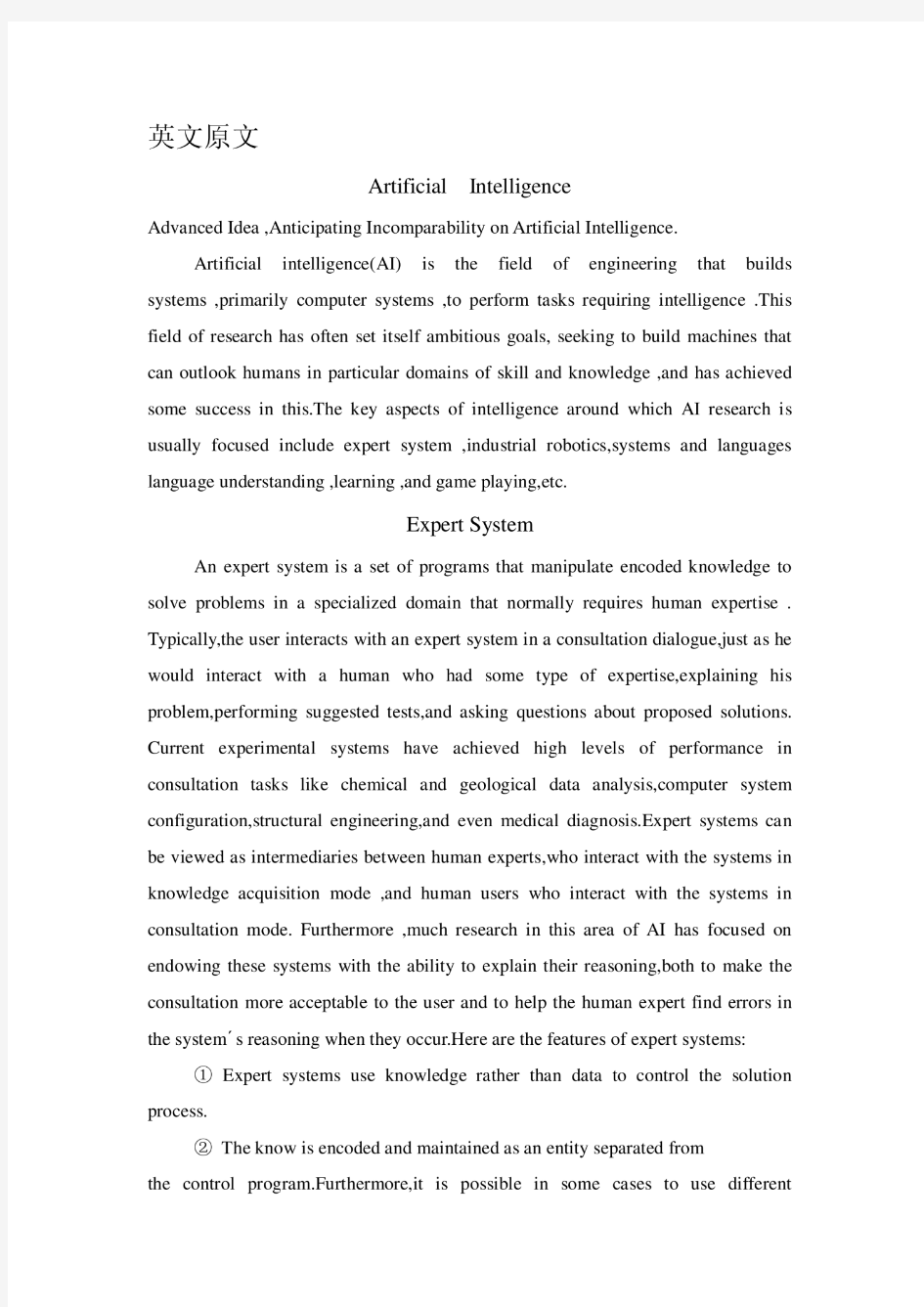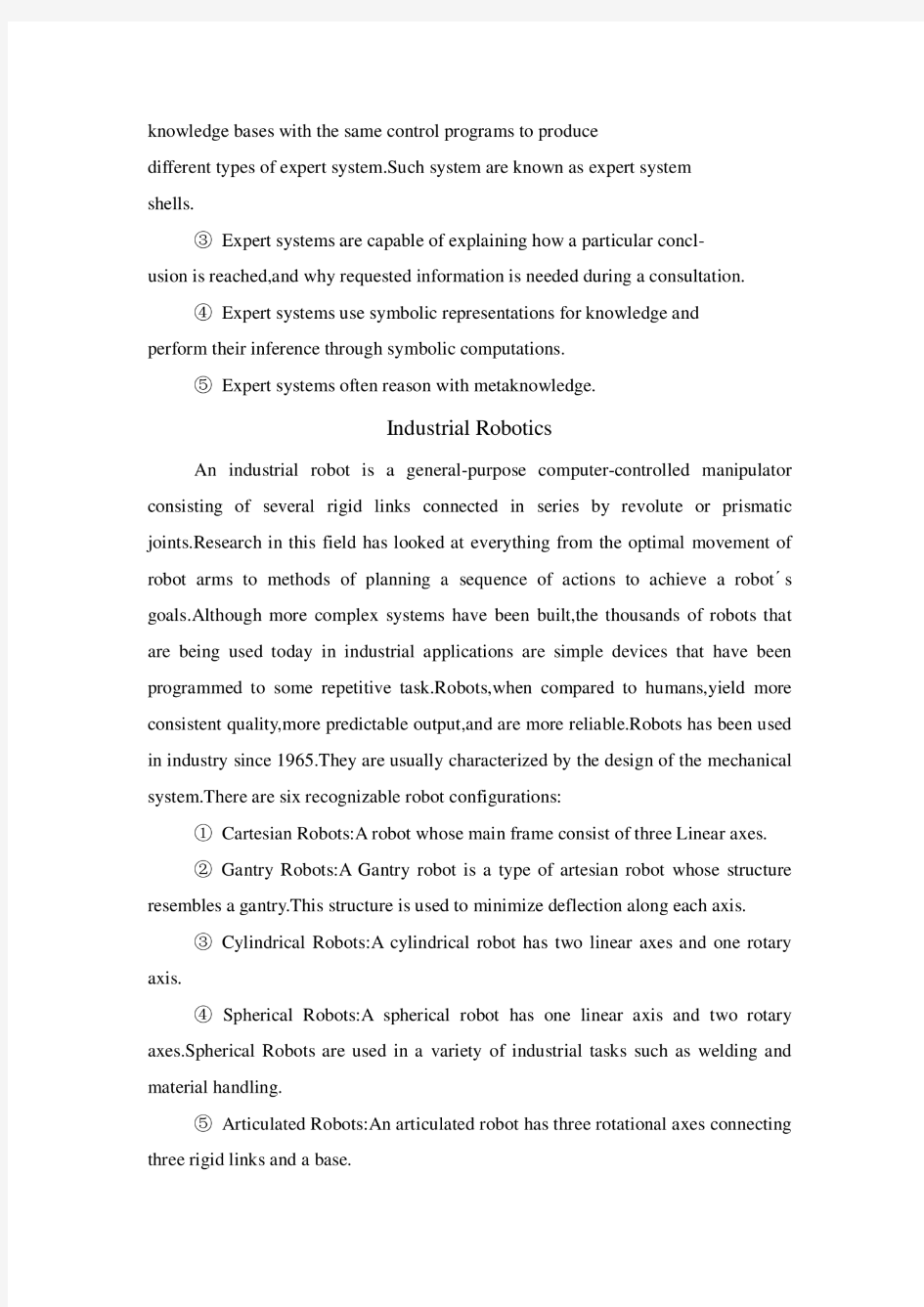人工智能外文翻译文献


人工智能专业外文翻译-机器人
译文资料: 机器人 首先我介绍一下机器人产生的背景,机器人技术的发展,它应该说是一个科学技术发展共同的一个综合性的结果,同时,为社会经济发展产生了一个重大影响的一门科学技术,它的发展归功于在第二次世界大战中各国加强了经济的投入,就加强了本国的经济的发展。另一方面它也是生产力发展的需求的必然结果,也是人类自身发展的必然结果,那么随着人类的发展,人们在不断探讨自然过程中,在认识和改造自然过程中,需要能够解放人的一种奴隶。那么这种奴隶就是代替人们去能够从事复杂和繁重的体力劳动,实现人们对不可达世界的认识和改造,这也是人们在科技发展过程中的一个客观需要。 机器人有三个发展阶段,那么也就是说,我们习惯于把机器人分成三类,一种是第一代机器人,那么也叫示教再现型机器人,它是通过一个计算机,来控制一个多自由度的一个机械,通过示教存储程序和信息,工作时把信息读取出来,然后发出指令,这样的话机器人可以重复的根据人当时示教的结果,再现出这种动作,比方说汽车的点焊机器人,它只要把这个点焊的过程示教完以后,它总是重复这样一种工作,它对于外界的环境没有感知,这个力操作力的大小,这个工件存在不存在,焊的好与坏,它并不知道,那么实际上这种从第一代机器人,也就存在它这种缺陷,因此,在20世纪70年代后期,人们开始研究第二代机器人,叫带感觉的机器人,这种带感觉的机器人是类似人在某种功能的感觉,比如说力觉、触觉、滑觉、视觉、听觉和人进行相类比,有了各种各样的感觉,比方说在机器人抓一个物体的时候,它实际上力的大小能感觉出来,它能够通过视觉,能够去感受和识别它的形状、大小、颜色。抓一个鸡蛋,它能通过一个触觉,知道它的力的大小和滑动的情况。第三代机器人,也是我们机器人学中一个理想的所追求的最高级的阶段,叫智能机器人,那么只要告诉它做什么,不用告诉它怎么去做,它就能完成运动,感知思维和人机通讯的这种功能和机能,那么这个目前的发展还是相对的只是在局部有这种智能的概念和含义,但真正完整意义的这种智能机器人实际上并没有存在,而只是随着我们不断的科学技术的发展,智能的概念越来越丰富,它内涵越来越宽。 下面我简单介绍一下我国机器人发展的基本概况。由于我们国家存在很多其
关于现代工业机械手外文文献翻译@中英文翻译@外文翻译
附录 About Modenr Industrial Manipulayor Robot is a type of mechantronics equipment which synthesizes the last research achievement of engine and precision engine, micro-electronics and computer, automation control and drive, sensor and message dispose and artificial intelligence and so on. With the development of economic and the demand for automation control, robot technology is developed quickly and all types of the robots products are come into being. The practicality use of robot not only solves the problems which are difficult to operate for human being, but also advances the industrial automation program. Modern industrial robots are true marvels of engineering. A robot the size of a person can easily carry a load over one hundred pounds and move it very quickly with a repeatability of 0.006inches. Furthermore these robots can do that 24hours a day for years on end with no failures whatsoever. Though they are reprogrammable, in many applications they are programmed once and then repeat that exact same task for years. At present, the research and development of robot involves several kinds of technology and the robot system configuration is so complex that the cost at large is high which to a certain extent limit the robot abroad use. To development economic practicality and high reliability robot system will be value to robot social application and economy development. With he rapid progress with the control economy and expanding of the modern cities, the let of sewage is increasing quickly; with the development of modern technology and the enhancement of consciousness about environment reserve, more and more people realized
文献综述_人工智能
人工智能的形成及其发展现状分析 冯海东 (长江大学管理学院荆州434023) 摘要:人工智能的历史并不久远,故将从人工智能的出现、形成、发展现 状及前景几个方面对其进行分析,总结其发展过程中所出现的问题,以及发展现状中的不足之处,分析其今后的发展方向。 关键词:人工智能,发展过程,现状分析,前景。 一.引言 人工智能最早是在1936年被英国的科学家图灵提出,并不为多数人所认知。 当时,他编写了一个下象棋的程序,这就是最早期的人工智能的应用。也有著名的“图灵测试”,这也是最初判断是否是人工智能的方案,因此,图灵被尊称为“人工智能之父”。人工智能从产生到发展经历了一个起伏跌宕的过程,直到目前为止,人工智能的应用技术也不是很成熟,而且存在相当的缺陷。 通过搜集的资料,将详细的介绍人工智能这个领域的具体情况,剖析其面临的挑战和未来的前景。 二.人工智能的发展历程 1. 1956年前的孕育期 (1) 从公元前伟大的哲学家亚里斯多德(Aristotle)到16世纪英国哲学家培根(F. Bacon),他们提出的形式逻辑的三段论、归纳法以及“知识就是力量”的警句,都对人类思维过程的研究产生了重要影响。 (2)17世纪德国数学家莱布尼兹(G..Leibniz)提出了万能符号和推理计算思想,为数理逻辑的产生和发展奠定了基础,播下了现代机器思维设计思想的种子。而19世纪的英国逻辑学家布尔(G. Boole)创立的布尔代数,实现了用符号语言描述人类思维活动的基本推理法则。 (3) 20世纪30年代迅速发展的数学逻辑和关于计算的新思想,使人们在计算机出现之前,就建立了计算与智能关系的概念。被誉为人工智能之父的英国天才的数学家图灵(A. Tur-ing)在1936年提出了一种理想计算机的数学模型,即图灵机之后,1946年就由美国数学家莫克利(J. Mauchly)和埃柯特(J. Echert)研制出了世界上第一台数字计算机,它为人工智能的研究奠定了不可缺少的物质基础。1950年图灵又发表了“计算机与智能”的论文,提出了著名的“图灵测试”,形象地指出什么是人工智能以及机器具有智能的标准,对人工智能的发展产生了极其深远的影响。 (4) 1934年美国神经生理学家麦克洛奇(W. McCulloch) 和匹兹(W. Pitts )建立了第一个神经网络模型,为以后的人工神经网络研究奠定了基础。 2. 1956年至1969年的诞生发育期 (1)1956年夏季,麻省理工学院(MIT)的麦卡锡(J.McCarthy)、明斯基(M. Minshy)、塞尔夫里奇(O. Selfridge)与索罗门夫(R. Solomonff)、 IBM的洛
论文《人工智能》---文献检索结课作业
人工智能 【摘要】:人工智能是一门极富挑战性的科学,但也是一门边沿学科。它属于自然科学和社会科学的交叉。涉及的学科主要有哲学、认知科学、数学、神经生理学、心理学、计算机科学、信息论、控制论、不定性论、仿生学等。人工智能(Artificial Intelligence),英文缩写为AI。它是研究、开发用于模拟、延伸和扩展人的智能的理论、方法、技术及应用系统的一门新的技术科学。人工智能是计算机科学的一个分支,它企图了解智能的实质,并生产出一种新的能以人类智能相似的方式做出反应的智能机器,该领域的研究包括机器人、语言识别、图像识别、自然语言处理和专家系统等1。 【关键词】:人工智能;应用领域;发展方向;人工检索。 1.人工智能描述 人工智能(Artificial Intelligence) ,英文缩写为AI。它是研究、开发用于模拟、延伸和扩展人的智能的理论、方法、技术及应用系统的一门新的技术科学2。人工智能是计 算机科学的一个分支,它企图了解智 能的实质,并生产出一种新的能以人 类智能相似的方式作出反应的智能 机器,该领域的研究包括机器人、语 言识别、图像识别、自然语言处理和 专家系统等。“人工智能”一词最初 是在1956 年Dartmouth学会上提出 的。从那以后,研究者们发展了众多 理论和原理,人工智能的概念也随之扩展。人工智能是一门极富挑战性的科学,从事这项工作的人必须懂得计算机知识,心理学和哲学。人工智能是包括十分广泛的科学,它由不同的领域组成,如机器学习,计算机视觉等等,总的说来,人工智能研究的一个主要目标是使机器能够胜任一些通常需要人类智能才能完成的复杂工作。但不同的时代、不同的人对这种“复杂工作”的理解是不同的。例如繁重的科学和工程计算本来是要人脑来承担的,现在计算机不但能完成这种计算, 而且能够比人脑做得更快、更准确,因之当代人已不再把这种计算看作是“需要人类智能才能完成的复 1.蔡自兴,徐光祐.人工智能及其应用.北京:清华大学出版社,2010 2元慧·议当人工智能的应用领域与发展状态〖J〗.2008
人工智能专家系统_外文翻译原文
附件 毕业生毕业论文(设计)翻译原文 论文题目远程农作物病虫害诊断专家系统的设计与实现系别_____ ______ _ 年级______ _ _ _ _ _ 专业_____ ___ ___ 学生姓名______ _____ 学号 ___ __ _ 指导教师______ ___ _ __ _ 职称______ __ ___ 系主任 _________________ _ _ ___ 2012年 04月22 日
EXPERT SYSTEMS AND ARTIFICIAL INTELLIGENCE Expert Systems are computer programs that are derived from a branch of computer science research called Artificial Intelligence (AI). AI's scientific goal is to understand intelligence by building computer programs that exhibit intelligent behavior. It is concerned with the concepts and methods of symbolic inference, or reasoning, by a computer, and how the knowledge used to make those inferences will be represented inside the machine. Of course, the term intelligence covers many cognitive skills, including the ability to solve problems, learn, and understand language; AI addresses all of those. But most progress to date in AI has been made in the area of problem solving -- concepts and methods for building programs that reason about problems rather than calculate a solution. AI programs that achieve expert-level competence in solving problems in task areas by bringing to bear a body of knowledge about specific tasks are called knowledge-based or expert systems. Often, the term expert systems is reserved for programs whose knowledge base contains the knowledge used by human experts, in contrast to knowledge gathered from textbooks or non-experts. More often than not, the two terms, expert systems (ES) and knowledge-based systems (KBS), are used synonymously. Taken together, they represent the most widespread type of AI application. The area of human intellectual endeavor to be captured in an expert system is called the task domain. Task refers to some goal-oriented, problem-solving activity. Domain refers to the area within which the task is being performed. Typical tasks are diagnosis, planning, scheduling, configuration and design. An example of a task domain is aircraft crew scheduling, discussed in Chapter 2. Building an expert system is known as knowledge engineering and its practitioners are called knowledge engineers. The knowledge engineer must make sure that the computer has all the knowledge needed to solve a problem. The knowledge engineer must choose one or more forms in which to represent the required knowledge as symbol patterns in the memory of the computer -- that is, he (or she) must choose a knowledge representation. He must also ensure that the computer can use the knowledge efficiently by selecting from a handful of reasoning methods. The practice of knowledge engineering is described later. We first describe the components of expert systems. The Building Blocks of Expert Systems Every expert system consists of two principal parts: the knowledge base; and the reasoning, or inference, engine.
智能机器人外文翻译
Robot Robot is a type of mechantronics equipment which synthesizes the last research achievement of engine and precision engine, micro-electronics and computer, automation control and drive, sensor and message dispose and artificial intelligence and so on. With the development of economic and the demand for automation control, robot technology is developed quickly and all types of the robots products are come into being. The practicality use of robot products not only solves the problems which are difficult to operate for human being, but also advances the industrial automation program. At present, the research and development of robot involves several kinds of technology and the robot system configuration is so complex that the cost at large is high which to a certain extent limit the robot abroad use. To development economic practicality and high reliability robot system will be value to robot social application and economy development. With the rapid progress with the control economy and expanding of the modern cities, the let of sewage is increasing quickly: With the development of modern technology and the enhancement of consciousness about environment reserve, more and more people realized the importance and urgent of sewage disposal. Active bacteria method is an effective technique for sewage disposal,The lacunaris plastic is an effective basement for active bacteria adhesion for sewage disposal. The abundance requirement for lacunaris plastic makes it is a consequent for the plastic producing with automation and high productivity. Therefore, it is very necessary to design a manipulator that can automatically fulfill the plastic holding. With the analysis of the problems in the design of the plastic holding manipulator and synthesizing the robot research and development condition in recent years, a economic scheme is concluded on the basis of the analysis of mechanical configuration, transform system, drive device and control system and guided by the idea of the characteristic and complex of mechanical configuration, electronic, software and hardware. In this article, the mechanical configuration combines the character of direction coordinate and the arthrosis coordinate which can improve the stability and operation flexibility of the system. The main function of the transmission mechanism is to transmit power to implement department and complete the necessary movement. In this transmission structure, the screw transmission mechanism transmits the rotary motion into linear motion. Worm gear can give vary transmission
人工智能研究方法的文献综述
人工智能研究方法的文献综述 1、前言 本文综述了人工智能的主要研究方法,并对各方法进行分析和总结,并阐述了目前人工智能研究方法日趋多样化的研究现状。 2、主题 研究方法,对一个问题的研究方法从根本上说分为两种:其一,对要解决的问题扩展到他所隶属的领域,对该领域做一广泛了解,研究该领域从而实现对该领域的研究,讲究广度,从对该领域的广泛研究收缩到问题本身;其二,把研究的问题特殊化,提炼出要研究问题的典型子问题或实例,从一个更具体的问题出发,做深刻的分析,研究透彻该问题,再一般化扩展到要解决的问题,讲究研究深度,从更具体的问题入手研究扩展到问题本身。 人工智能的研究方法主要可以分为三类:一、结构模拟,神经计算,就是根据人脑的生理结构和工作机理,实现计算机的智能,即人工智能。结构模拟法也就是基于人脑的生理模型,采用数值计算的方法,从微观上来模拟人脑,实现机器智能。采用结构模拟,运用神经网络和神经计算的方法研究人工智能者,被称为生理学派、连接主义。二、功能模拟,符号推演,就是在当前数字计算机上,对人脑从功能上进行模拟,实现人工智能。功能模拟法就是以人脑的心理模型,将问题或知识表示成某种逻辑网络,采用符号推演的方法,实现搜索、推理、学习等功能,从宏观上来模拟人脑的思维,实现机器智能。以功能模拟和符号推演研究人工智能者,被称为心理学派、逻辑学派、符号主义。三、行为模拟,控制进化,就是模拟人在控制过程中的智能活动和行为特性。以行为模拟方法研究人工智能者,被称为行为主义、进化主义、控制论学派。 人工智能的研究方法,已从“一枝独秀”的符号主义发展到多学派的“百花争艳”,除了上面提到的三种方法,又提出了“群体模拟,仿生计算”“博采广鉴,自然计算”“原理分析,数学建模”等方法。人工智能的目标是理解包括人在内的自然智能系统及行为,而这样的系统在实在世界中是以分层进化的方式形成了一个谱系,而智能作为系统的整体属性,其表现形式又具有多样性,人工智能的谱系及其多样性的行为注定了研究的具体目标和对象的多样性。人工智能与前沿技术的结合,使人工智能的研究日趋多样化。 3、总结 人工智能的研究方法会随着技术的进步而不断丰富,很多新名词还会被提出,但研究的目的基本不变,日趋多样化的研究方法追根溯源也就是研究问题的两种方法的演变。对人工智能中尚未解决的众多问题,运用基本的研究问题的方法,结合先进的技术,不断实现智能化。人工智能与前沿技术密切联系,人工智能的研究方法必然日趋多样化。 4、参考文献 (1)人工智能技术导论廉师友西安电子科技大学出版社2007.8 (2)人工智能研究方法及途径熊才权2005年第三期 (3)人工智能学派及其在理论、方法上的观点蔡自兴1995.5 (4)人工智能研究的主要学派及特点黄伟聂东陈英俊2001第三期 (5)人工智能研究对思维学的方法论启示尹鑫苏国辉2002.10第四期
英文翻译人工智能
【PT】[J]. 【AU:】shambour,Qusai Xu, Yisi Lin, Qing Zhang, Guangquan 【AB】The web provides excellent opportunities to businesses in various aspects of development such as finding a business partner online. However, with the rapid growth of web information, business users struggle with information overload and increasingly find it difficult to locate the right information at the right time. Meanwhile, small and medium businesses (SMBs), in particular, are seeking one-to-one e-services from government in current highly competitive markets. How can business users be provided with information and services specific to their needs, rather than an undifferentiated mass of information? An effective solution proposed in this study is the development of personalized e-services. Recommender systems is an effective approach for the implementation of Personalized E-Service which has gained wide exposure in e-commerce in recent years. Accordingly, this paper first presents a hybrid fuzzy semantic recommendation (HFSR) approach which combines item-based fuzzy semantic similarity and item-based fuzzy collaborative filtering (CF) similarity techniques. This paper then presents the implementation of the proposed approach into an intelligent recommendation system prototype called Smart BizSeeker, which can recommend relevant business partners to individual business users,particularly for SMBs. Experimental results show that the HFSR approach can help overcome the semantic limitations of classical CF-based recommendation approaches, namely sparsity and new cold start item problems. 【题目】:基于Web的个性化推荐系统使用的业务合作伙伴---模糊语义技术 【刊登杂志】: 计算智能 【摘要】网站为企业在各方面的发展提供了极好的机会,例如找到一个在线的业务合作 伙伴。然而,随着网络信息的快速增长,商业用户正在和信息过载做斗争,并且在正确的时间找到正确的信息的难度在不断增加。同时,特别是中小型企业(中小企业),在当前竞争激烈的市场中从政府寻求的是一对一的电子服务。怎么为企业用户提供他们需要的的信息和服务,而不是一种未分化的海量信息?本文中就为个性化服务发展提出了一个有效的解决方法。推荐系统是实施个性化的全方位服务的一种有效的方法,近年来在电子商务中得到了广泛的提及。相应的,本文首先提出了一种混合模糊语义推荐(HFSR)的方法,这种方法结合了基于项目的模糊语义相似度和基于项目的模糊协同过滤(CF)相似的技术。本文就介绍了在一个智能推荐系统原型中该方法的实现,这个实现方法称为智能bizseeker,它可推荐相关个人商务用户的业务合作伙伴,特别是对中小企业。实验结果表明,HFSR方法可以帮助克服基于推荐的经典CF语义的限制方法,即稀疏性和冷开始新项目问题。
计算机j2ee动态配置中英文对照外文翻译文献
中英文资料外文翻译文献 基于J2EE在分布式环境下的底层结构的自动动态配置的应用 摘要:为了实现广域网中符合工业标准基于组件的应用程序中动态的可适应性,我们需要一种框架来在这样的环境里自动化地配置J2EE 应用程序。这种需要对于哪怕在单一的应用程序服务器上尝试部署J2EE应用的人来说也显而易见,这种任务设计到大量的系统服务和应用组件的配置。 关键词:j2ee;动态配置;分布式;组件; 1 前言 近几年,我们已经看到基于组件的企业应用开发的显著增加。这种应用程序通常被部署在公司的内部网或者是因特网上,以高事务容量,大量的用户和覆盖范围广的访问为特征,它通常会被部署在中央区域,采用服务器集群来均衡负载从而支持用户下载。但是这种平均负荷的方法被证明只对减少应用转发的用户可以察觉的反应时间有效,而对于减少网络方面的延迟作用不大,垂直分割(例如…运行网络层和事务层在不同的虚拟机)被用于错误分离和均衡负荷,但是它是不符合实际的由于远程调运的大量使用显著地增加了运行时时间。最近的著作已经表明在广域网中利用垂直负荷而不引起前面所述的超时问题的可行性。那非研究的主要结论可以概括如下: (1) 应用合适的应用程序,在广域网中的垂直负荷可以察觉的延迟。 (2) 广域垂直层需要复制应用层组件而且需要维持和原组件间的一致性。 (3) 新加的复制组件可以被动态配置以满足新的需要。 (4) 事实上,不同的复制组件可能会根据应用不同的方式实现相组件。 (5) 新的请求路径可以复用先前的组件配置路径。 应用智能监视和人工智能规划方法再结合那个研究得出的结论,我们看到通过动态布置基于动态监视的额外的应用组件,在广域网中符合工业标准基于组件的应用程序中动态的可适应性是可以实现的。然而,为了实现这种动态可适性,我们需要一种框架来在这样的环境里自动化地配置J2EE 应用程序。这种需要对于哪怕在单一的应用程序服务器上尝试布置J2EE应用的人来说也显而易见,这种任务设计到大量的系统服务和应用组件的配置。例如你必须在配置和部署应用组件前先建立JDBC数据源,设立消息目的地和资源适配器。在需要跨越多个节点服务器的广域网配置中,这将更加复杂,因为
人工智能 中英文翻译(升序排列)
B 规则B-rule F 规则F-rule NP 完全问题 NP-complete problem 本原问题primitive problem 博弈game 不可解标示过程unsolvable-labeling procedure 不可解节点unsolvable node 不可满足集unsatisfiable set 不确定性uncertainty 差别difference 产生式production 产生式规则production rule 冲突解决conflict resolution 存在量词existential quantifier 代换substitution 代换例substitution instance 倒退值backed-up value 等价equivalence 定理证明theorem-proving 动作action 反演refutation 反演树refutation tree 费用cost 估计费用estimated cost 估值函数evaluation function 归结resolution 归结反演resolution refutation 归结式resolvent 归结原理resolution principle 归约reduction 合取conjunction 合取范式conjunctive normal form 合取式conjunct 合适公式、合式公式well-formed formula (wff) 合一unifier 回答语句answer statement 回溯backtracking 机器学习machine learning 节点的扩展expansion of node 解释器interpreter 解树solution tree 解图solution graph 句子sentence 可解标示过程solvable labeling procedure 可解节点solvable node 可满足性satisfiability 空子句empty clause 控制策略control strategy 宽度优先搜索 breadth-first search 扩展节点expending node 连词,连接词 connective 量词quantifier 量词辖域scope of quantifier 论域,文字域domain of discourse 逻辑logic 逻辑连词logic connective 逻辑推理logic reasoning 盲目搜索,无信息搜 blind search 模式匹配match pattern 模式识别Pattern recognition 母式matrix 逆向推理backward reasoning 匹配match 启发函数heuristic function 启发式搜索Heuristic search 启发搜索heuristic search 启发信息heuristic information 前缀prefix 全称量词universal quantifier 全局数据库Global database 人工神经网络artificial neural network 人工智能artificial intelligence,AI 人工智能语言AI language 深度优先搜索 depth-first search 事实fact 搜索search, searching 搜索策略searching strategy 搜索树searching tree 搜索算法searching algorithm 搜索算法的效率 efficiency of search algorithm 搜索图searching graph 算符、算子、操作符 operator 图graph 图表示法graph notation 图搜索graph search 图搜索控制策略 graph-search control strategy 推导表,引导图 derivation graph 推理inference 推理reasoning 推理机reasoning machine 谓词predicate 谓词逻辑predicate logic 谓词演算predicate calculus 谓词演算公式wffs of predicate calculus 谓词演算辖域domain in predicate calculus 文字literal 问题归约 problem-reduction 问题求解problem solving 析取disjunction 析取式disjunct 线形输入形策略 linear-input form strategy 项term 学习learning 演绎deduction 一阶谓词演算first order predicate calculus 一致解图consistant solution graph 遗传算法genetic algorithm 永真式validity 有向图directed graph 有序搜索ordered search 与或树AND/OR tree 与或图AND/OR graph 与节点AND node 原子公式atomic formula 蕴涵,蕴涵式 implication 正向推理forward reasoning 知识knowledge 知识工程knowledge engineering 知识获取knowledge acquisition 知识库knowledge base 智能intelligence 重言式tautology 专家系统Expert system 状态state 状态空间state space 子句clause 自动定理证明 automatic theorem proving 组合爆炸combinatorial explosion 祖先过滤形策略 ancestry-filtered form strategy 最一般合一most general unifier 最一般合一者most general unifier 最优解树optimal solution tree
人工智能英文文献原文及译文
附件四英文文献原文 Artificial Intelligence "Artificial intelligence" is a word was originally Dartmouth in 1956 to put forward. From then on, researchers have developed many theories and principles, the concept of artificial intelligence is also expands. Artificial intelligence is a challenging job of science, the person must know computer knowledge, psychology and philosophy. Artificial intelligence is included a wide range of science, it is composed of different fields, such as machine learning, computer vision, etc, on the whole, the research on artificial intelligence is one of the main goals of the machine can do some usually need to perform complex human intelligence. But in different times and different people in the "complex" understanding is different. Such as heavy science and engineering calculation was supposed to be the brain to undertake, now computer can not only complete this calculation, and faster than the human brain can more accurately, and thus the people no longer put this calculation is regarded as "the need to perform complex human intelligence, complex tasks" work is defined as the development of The Times and the progress of technology, artificial intelligence is the science of specific target and nature as The Times change and development. On the one hand it continues to gain new progress on the one hand, and turning to more meaningful, the more difficult the target. Current can be used to study the main material of artificial intelligence and artificial intelligence technology to realize the machine is a computer, the development history of artificial intelligence is computer science and technology and the development together. Besides the computer science and artificial intelligence also involves information, cybernetics, automation, bionics, biology, psychology, logic, linguistics, medicine and philosophy and multi-discipline. Artificial intelligence research include: knowledge representation, automatic reasoning and search method, machine learning and knowledge acquisition and processing of knowledge system, natural language processing, computer vision, intelligent robot, automatic program design, etc. Practical application of machine vision: fingerprint identification,
